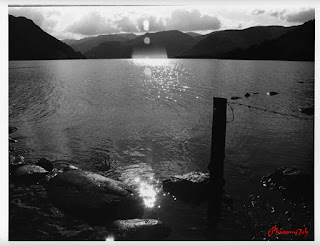I
like trying new things out in the darkroom, so when an offer to
use Tetenal's new monochrome paper developer Eukobrom AC came up I
jumped at it. I would like to thank Matt of AG Photographic and
Tetenal for the chance to be one of the first to give it a test
drive. A few weeks later a package arrived at the door, since then I
have been chafing at the bit to try it out.
This
is a new developer made for twenty first century. It is also the
first commercially to use isoascorbate, vitamin
C (you're not seeing things) as the main developing agent, it is a
direct replacement for Hydroquinone the most widely used ingredient
in photographic developers, noted for it's fast action and high
contrast. It is marketed as the alternative to Ilfords multigrade
all purpose paper developer producing the same sort of neutral tones.
The developer works with both Fiber Baryta and resin coated light
sensitive papers, whether multigrade or graded.
 |
Top row: Ilford multigrade RC paper. left side in
multigrade developer. Right side Tetenal.
Bottom row: Fomaspeed variant RC paper. |
The
data at the moment is quite sparse.
Technical
Data:
Fibre
Baryta
Paper
(FB)
|
Dilution
|
20C
|
25C
|
30C
|
1+4
|
90s
|
70s
|
50s
|
1+9
|
100s
|
80s
|
60s
|
Resin
coated
paper
|
1+4
|
50s
|
30s
|
15s
|
1+9
|
70s
|
50s
|
30s
|
All
information is provided for guidance only. Deviations may arise,
depending
upon the paper used. Shortening or extending the development
time
by up to 10% is possible.
 |
| Diluted 1+9 Eukobrom |
In
to the Darkroom.
The
first thing you notice with this developer is it's lack of odour. The
next is the colour of the liquid, a rich yellow. I decided to dilute
at 1+9. Once done I poured the contents of the measuring jug into a
tray. I would have used my up right paper processor but that already
had fresh Ilford multigrade in it. Using the tray for the new
developer would allow me to note how long it took for the image to
start appearing.
The
comparison.
I
have several makes of light sensitive paper in stock. I chose three,
the most obvious Ilfords multigrade, Fomaspeed Variant 311 and
Kentmere VC select gloss, all resin coated papers. I went to these first
as they are reasonable quick to process and give an insight into how
the Eukobrom will perform. Before moving on to FB papers. (results to follow in another post)
The set up.
I chose a negative from a recently developed set of Agfa APX100. I set the height of the enlarger so it would produce an enlargement of 9 x 12 then set the easel to 8x10. I did this because the Kentmere paper I wanted to include I only had in 9x12, this would keep everything consistent.
 |
Ilford multigrade RC paper
developed in Tetenal developer | |
The
test strip was processed in the multigrade developer and it was
indicating that the image would need to be dodged, if I wanted a
picture I was happy with. I set the enlarger as follows lens F8,
grade 3, exposure: The whole image was exposed for twelve seconds,
the sky from the bridge upwards plus eighteen seconds and finally the
sky from half way up to the top of the image plus eighteen seconds. I
would produce two pictures on each paper all at the same setting. The
developers temperature was set at 20C.
 |
Ilford multigrade RC
Paper developed in Multigrade |
Results:
Both
developers are advertised as neutral tone. To me this means they are
subtlety on the cool side.
The
differentiation started with:
The
Ilford paper when compared with the other papers in the test,
has a slight warmth to it's tone when developed in fresh multigrade.
The Eukobrom is slightly cooler in look with a more intense black
and crisper whites giving it a bit more contrast.
The
Fomaspeed paper has a cooler look to it when developed in
multigrade compared to the Ilford paper. The Eukobrom proved to be
cooler looking again with more intense blacks and clearer whites
again adding to the contrast.
The
Kentmere paper is known to have a higher contrast level to the
previous papers mentioned maybe as much as a grade. When developed
in multigrade the image had a muddy look to it indicating over
exposure with a slightly warm feel to it. The Eukobrom processed
image had a cleaner crisper look. Again the midtones had better
separation making it look more like a moon light picture instead of
over exposed.
 |
Fomaspeed variant RC
developed in Tetenal |
Once you understand that Eukobrom adds contrast to the image possibly more so than the Hydroquinone it replaces. It is easy to allow for by reducing the grade you would normally use. The blacks are wonderfully rich giving the pictures some real punch. The mid tones have more separation than Ilford multigrade but the surprise is the brightness of the whites.
 |
Fomaspeed variant RC
developed in Multigrade |
Personally the main questions yet to be resolved are its keeping qualities and whether or not the image will be warm when the developer starts to deplete.
 |
Kentmere paper.
Top Row: exposed at grade three.
Right side Tetenal developer. Left multigrade.
Bottom row: exposed at grade two. |
This
is a nice developer to work with for prolonged periods as you do not
get that developer smell lingering up your nose afterwards. Oh! It
does look like OJ when diluted so keep it out of the reach of kids.
It is a real gem and I will be ordering a bottle, it may even replace
my favorite multigrade! Don't take my word for it try it for
yourself you will not be disappointed.
















































